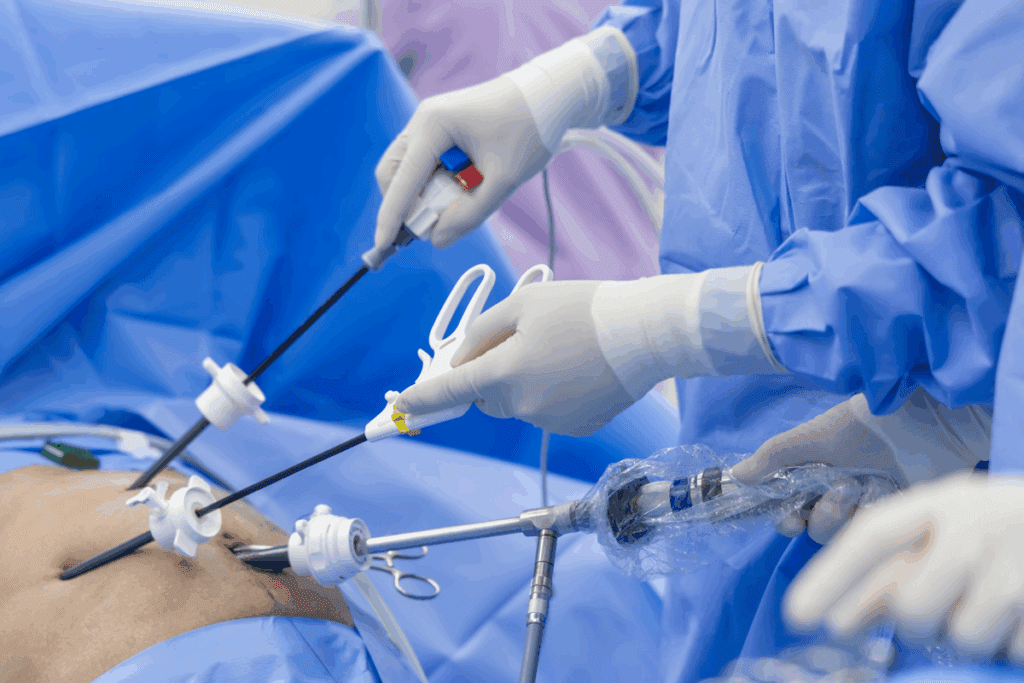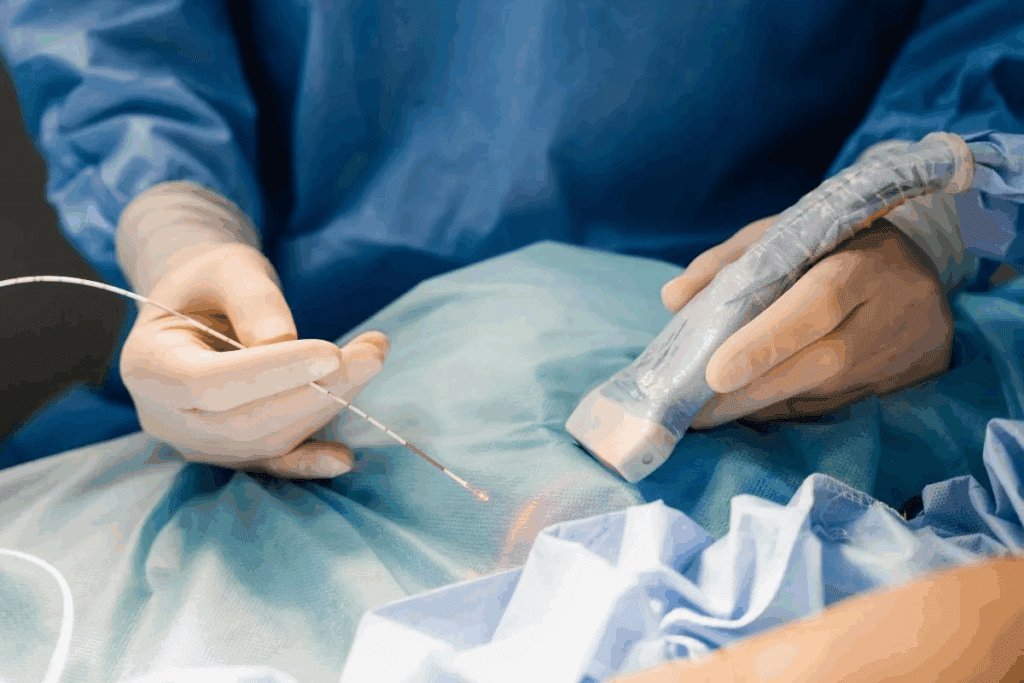Last Updated on November 26, 2025 by Bilal Hasdemir

At Liv Hospital, we understand that invasive surgery can feel intimidating. Many patients want to know the definition of invasive surgery and what it involves.
Invasive surgeries are procedures that require making cuts or using instruments to access the inside of the body. These can range from small procedures, like biopsies, to major operations, such as heart surgery.
Our team at Liv Hospital prioritizes patient safety and recovery. With a group of skilled experts following international medical standards, we ensure that every procedure is performed with precision, care, and attention to your well-being. Understanding the definition of invasive surgery helps patients feel more informed and confident about their treatment options.
Key Takeaways
- Invasive surgeries involve making incisions or using instruments to access the body.
- Procedures can range from minor to major surgeries.
- Expert medical care is key for your safety and success.
- Liv Hospital is all about caring for you.
- Our team sticks to the highest medical standards.
The Definition of Invasive Surgery and Its Scope

It’s important for both patients and doctors to know about invasive surgery. It’s a type of complex medical treatment that involves big cuts or insertions. These surgeries are needed for serious health problems that can’t be fixed without them.
We’ll look at how surgeries are classified as invasive. This helps us understand their role in today’s medicine.
Medical Criteria for Classifying Surgical Invasiveness
Doctors use several factors to decide how invasive a surgery is. These include how much tissue is affected, the size of the cut, and the surgery’s risks. This helps them choose the right care for each patient.
The main criteria for invasive surgery are:
- The size and location of the incision
- The extent of tissue disruption or damage
- The risk of complications or adverse reactions
- The need for anesthesia and pain management
- The expected recovery time and postoperative care requirements
| Criteria | Description | Examples |
| Incision Size | The larger the incision, the more invasive the procedure | Open-heart surgery vs. laparoscopic surgery |
| Tissue Disruption | Procedures that cause more tissue damage are considered more invasive | Organ transplant vs. minor skin excision |
| Risk Level | Procedures with higher risks of complications are classified as more invasive | Neurosurgery vs. cataract surgery |
Key Characteristics That Define Invasive Procedures
Invasive procedures let doctors directly reach internal organs or tissues. They use cuts or insertions to do this. These surgeries need anesthesia, can have risks, and need care after.
Invasive medical treatments are key for serious health issues. They include surgeries, biopsies, and more, all needing to enter the body.
Knowing about invasive surgery helps patients understand its complexities and risks. It also shows the need for skilled doctors and modern tech in these surgeries.
Types of Invasive Procedures Across Medical Specialties

Invasive procedures are key in modern medicine. They help diagnose and treat many health issues. These methods are used for both finding out what’s wrong and fixing problems.
Diagnostic Invasive Procedures
Diagnostic invasive procedures help find and understand health problems. Biopsies are a common one, where tissue samples are taken for tests. This helps diagnose things like cancer.
Another example is angiography. It involves putting a contrast agent into blood vessels. This lets doctors see the blood vessels and find any blockages or issues.
Therapeutic Invasive Interventions
Therapeutic invasive interventions aim to treat health issues. Angioplasty is a notable one. It uses a balloon to widen a blocked or narrowed artery.
Often, stenting is done too. This involves placing a small mesh tube to keep the artery open. It’s done alongside angioplasty.
Major Reconstructive and Life-Saving Surgeries
Major reconstructive and life-saving surgeries are very complex. Organ transplants are a great example. They replace a sick or damaged organ with a healthy one from a donor.
These surgeries need careful planning and a team of experts. They save lives and greatly improve the quality of life for many patients.
How Invasive Procedures Access the Body
Invasive procedures need to get into the body to work. They use various surgical methods. These surgeries aim to diagnose, treat, or fix health issues. How they get into the body is key to their success.
Traditional Open Surgical Approaches
Open surgery makes a big cut to reach the body part needing surgery. This method lets surgeons see and work on the area directly. It’s good for complex surgeries.
Advantages of Open Surgery:
- Direct view of the surgical site
- Ability to do complex procedures
- Control over the area
Percutaneous Entry Methods
Percutaneous methods use needles or small cuts to get into the body. They are less invasive than open surgery. These methods are often used for tests or treatments.
| Procedure | Description | Benefits |
| Biopsy | Sampling tissue for diagnostic purposes | Minimally invasive, quick recovery |
| Drainage | Draining fluid or abscesses | Reduces risk of infection, less trauma |
Endoscopic and Natural Orifice Techniques
Endoscopic surgery uses a tube with a camera and light to see inside the body. Natural orifice techniques use the body’s openings for surgery. This reduces the need for cuts.
These modern methods cause less damage, shorten recovery times, and lower complication risks. They’re great for surgeries in the gut, lungs, and other easy-to-reach areas.
Understanding how invasive procedures access the body shows the complexity of surgery. Each method has its own use, benefits, and risks. This highlights the importance of choosing the right procedure for each patient.
Essential Tools and Technology in Modern Invasive Surgery
Invasive surgery has changed a lot thanks to new medical tech and tools. These changes have made surgeries more precise and safe. They also let doctors treat more conditions.
Cutting and Dissection Instruments
Cutting and dissecting are key parts of surgery. Today, we have many tools for these tasks, like:
- Scalpels and lancets for precise cuts
- Surgical scissors for cutting tissue
- Electrocautery devices for cutting and stopping bleeding
These tools help surgeons work better and cause less damage. This means patients heal faster.
Visualization and Imaging Equipment
Seeing what’s happening inside the body is very important in surgery. New imaging tech has made things better:
- High-definition cameras show the surgery area clearly
- Fluoroscopy and CT scans give live images during surgery
- 3D tech helps plan and guide surgery
A leading surgeon said,
“New imaging tech has changed surgery. It lets us do more complex surgeries with better results.”
Specialized Instruments for Complex Procedures
For tough surgeries, we use special tools, like:
- Microsurgical tools for small, detailed work
- Robotic systems for better control and precision
- Endoscopic tools for less invasive surgeries
These tools help us do more detailed surgeries safely and well.
Keeping up with new surgical tools and tech is key. It helps us do better surgeries and treat more patients.
Most Common Invasive Medical Treatments Worldwide
Invasive surgeries are key in treating many health issues worldwide. They are vital in modern healthcare. They help solve complex health problems that affect millions.
Cardiovascular Invasive Procedures
Heart diseases are a major cause of death globally. Invasive heart treatments are lifesaving. Coronary artery bypass grafting (CABG) and angioplasty are common treatments for heart disease.
| Procedure | Description | Indications |
| CABG | Surgical procedure to improve blood flow to the heart | Severe coronary artery disease |
| Angioplasty | Procedure to widen narrowed or obstructed arteries | Coronary artery stenosis |
Abdominal and Gastrointestinal Surgeries
Abdominal and gastrointestinal surgeries include many procedures. From appendectomies to pancreatic resections, they treat conditions like appendicitis and gallstones. They also treat gastrointestinal cancers.
Orthopedic Invasive Interventions
Orthopedic surgeries treat musculoskeletal disorders and injuries. Procedures like joint replacements and spinal surgeries aim to restore function and relieve pain. They improve patients’ quality of life.
Neurosurgical Procedures
Neurosurgery treats conditions of the brain, spine, and nervous system. It includes craniotomies for tumor removal and spinal decompression surgeries. These surgeries are critical for treating serious neurological conditions.
In conclusion, invasive medical treatments are diverse and vital in healthcare worldwide. Understanding these procedures highlights the complexity and importance of surgical interventions in modern medicine.
Patient Preparation and Recovery for Invasive Surgery
Invasive surgeries need careful planning before and after. This includes checking the patient’s health, using the right anesthesia, and caring for them after surgery. The success of these surgeries depends a lot on how well patients are prepared and cared for.
Preoperative Assessment and Preparation
Checking the patient before surgery is very important. We look at their medical history, current health, and any risks. We make sure they have the right tests to find any issues that might affect the surgery or recovery.
Key parts of getting ready for surgery include:
- Reviewing medical history
- Doing a physical exam
- Running tests and scans
- Looking at medications and adjusting them if needed
- Telling patients what to do before surgery
| Preoperative Test | Purpose |
| Blood Tests | To check overall health and find any hidden conditions |
| Electrocardiogram (ECG) | To check the heart’s function |
| Imaging Studies (X-rays, CT scans) | To see the area to be operated on and plan the surgery |
Anesthesia Considerations
Anesthesia is key for keeping patients comfortable and pain-free during surgery. We pick the best anesthesia based on the surgery, the patient’s health, and past experiences with anesthesia.
The anesthesia team works closely with the surgical team to:
- Choose the best anesthesia plan
- Watch the patient’s vital signs during surgery
- Manage pain and discomfort after surgery
Postoperative Care and Rehabilitation
After surgery, care is very important for a good recovery. We focus on managing pain, preventing problems, and helping the patient get back to normal. A good rehabilitation plan helps patients get strong and mobile again.
Parts of postoperative care include:
- Managing pain
- Looking after the wound and watching for infection
- Physical therapy and rehabilitation
- Helping with nutrition and giving advice
- Following up with appointments and checking on the patient
By focusing on preparation and care after surgery, we can greatly improve results for patients. Our goal is to give patients the support they need from start to finish.
Risks and Complications Associated with Invasive Procedures
Invasive surgeries are often lifesaving but carry risks and complications. Patients and healthcare providers must weigh these carefully. It’s important to grasp the factors that lead to these risks.
Common Surgical Complications
Surgical complications can stem from several factors. These include the patient’s health, the procedure’s complexity, and the surgical team’s skill. Common issues include:
- Infection: Bacterial infections can happen at the surgical site. They can be serious if not treated quickly.
- Bleeding: Too much bleeding during or after surgery might need extra steps, like blood transfusions.
- Organ Damage: There’s a big risk of harming nearby organs or tissues in invasive surgeries.
Anesthesia-Related Risks
Anesthesia is key for pain-free surgery. But, it also has risks. These include:
- Respiratory Complications: People with breathing problems are more likely to face breathing issues under anesthesia.
- Cardiovascular Issues: Anesthesia can mess with heart rate and blood pressure, which is risky for heart patients.
- Allergic Reactions: Some might be allergic to certain anesthetics, leading to severe reactions.
Procedure-Specific Complications
Each invasive procedure has its own risks. For instance, surgeries in the abdominal area might lead to bowel obstruction or adhesions. Knowing these risks is vital for surgeons and patients to make smart choices.
By recognizing and understanding the risks of invasive procedures, we can improve surgical care. This helps in reducing these risks for better patient outcomes.
Comparing Invasive vs. Minimally Invasive Approaches
The world of surgery is changing fast. We’re seeing more focus on comparing invasive and minimally invasive methods. As medical tech improves, it’s key to understand the differences between these surgical types. This is important for doctors and patients alike.
When Traditional Invasive Surgery Is Necessary
Traditional invasive surgery is often needed for many health issues. Complex surgeries that need direct access to organs or tissues usually require this method. For example, some heart surgeries, big cancer surgeries, and complex brain surgeries need traditional methods. This is because they need clear views and precise handling of tissues.
Even though new, minimally invasive methods have come a long way, sometimes traditional surgery is the best choice. Doctors choose invasive surgery after thinking about the patient’s health, the surgery’s nature, and the risks and benefits.
Benefits of Minimally Invasive Alternatives
Minimally invasive surgery has changed surgery for the better. It offers key benefits like shorter recovery times, less pain, and smaller scars. This is because these surgeries use smaller cuts, causing less damage than open surgery.
Many surgeries, like those in orthopedics, stomach, and women’s health, are now done minimally invasively. These methods not only help patients heal faster but also make healthcare more efficient. They cut down on hospital stays and help people get back to their lives sooner.
Emerging Technologies Reducing Surgical Invasiveness
New technologies are making surgery less invasive. Robotic-assisted surgery, for instance, makes minimally invasive surgeries more precise. This lets doctors do more complex surgeries through smaller cuts.
Advances in imaging and surgical tools are also making surgery less invasive. These improvements help make surgeries safer and more effective. They also let doctors treat more conditions with minimally invasive methods, giving patients better and safer options.
Conclusion: The Future of Invasive Surgery in Modern Medicine
Invasive surgery is on the verge of big changes. New techniques, technology, and care methods are leading the way. This is a time when old ways are getting better, and new ones are being tried to help patients more.
New surgical methods are making procedures more precise and effective. Modern medicine is using advanced tech, like robots and imaging tools, to reduce risks and get better results. These steps are not just adding new options but also making care better overall.
We expect more innovation in invasive surgery as we look ahead. New tech and improved surgical methods will be key. Our goal is to provide top-notch care that meets our patients’ changing needs.
FAQ
What is an invasive surgery?
Invasive surgery is a medical procedure that makes a big cut or uses tools inside the body. It’s done to find or fix a health problem.
What are the key characteristics that define invasive procedures?
Invasive procedures reach inside the body. They need big cuts or tools to get there. They’re used for serious health issues.
What are the different types of invasive procedures used across various medical specialties?
There are many types of invasive procedures. These include biopsies, angioplasty, and organ transplants. They’re used in many medical fields.
How do invasive procedures access the body?
Invasive procedures use different ways to get inside the body. This includes open surgery, small cuts, and new methods like endoscopy.
What are the essential tools and technologies used in modern invasive surgery?
Modern surgery uses special tools and equipment. This includes cutting tools, cameras, and advanced instruments. These tools make surgery safer and more effective.
What are some common invasive medical treatments performed worldwide?
Many treatments are used worldwide. These include heart surgeries, stomach and intestine operations, bone surgeries, and brain surgeries. They’re key in healthcare.
How can patients prepare for invasive surgery?
Patients should get ready before surgery. This includes tests and learning about anesthesia. They also need to follow instructions for after the surgery.
What are the possible risks and complications of invasive procedures?
Surgery can have risks and problems. These include usual surgery issues, risks from anesthesia, and specific problems from the procedure. Knowing these helps patients make better choices.
What is the difference between invasive and minimally invasive surgical approaches?
Invasive surgery uses big cuts or tools. Minimally invasive surgery uses small cuts and new techniques. It causes less damage and helps patients recover faster.
What are some emerging technologies reducing surgical invasiveness?
New technologies like robotic surgery and better imaging are making surgery less invasive. They help improve results for patients.
Define invasive procedure.
An invasive procedure is a medical action that goes into the body. It uses cuts or tools to find or fix health issues.
What does invasive surgery mean?
Invasive surgery is a big operation. It makes a big cut or uses tools to fix a health problem.






